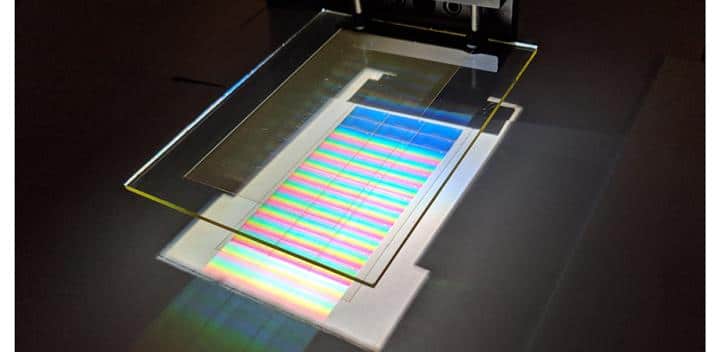From pv magazine Global
Scientists from the University of Arizona in the United States have created a holographic light collector which they claim is able to increase the efficiency of solar panels by up to 4.5%.
Presented in the paper “Holographic low concentration optical system increasing light collection efficiency of regular solar panels”, published in the Journal of Photonics for Energy (JPE), the collector is built with a low-cost holographic optical element (HOE) and a diffuser and can be easily embedded into conventional PV modules, according to its creators.
In this system design, the optical element is placed symmetrically at the center of the solar panel in order to increase the length of the effective light collection region. “The left half of the HOE diffracts light to a PV cell on the left side of the inactive module surface area (IMSA), and the right half of the HOE diffracts light to a cell on the right,” the academics explained, adding that each hologram in the proposed system is able to separate the colours of sunlight and direct them to the solar cells within the solar panel.
According to the researchers, this system configuration allows the light diffracted from the collector to exceed the critical angle of the module’s glass cover, which in turn extends the distance over which light can be collected and transferred to the solar cells. The diffuser scatters the light that is not diffracted by the HOE.
The light collector was tested in PV systems with dual-axis and single-axis tracking, as well as in a fixed non-tracking array. Multiple interactions of light scattered by the diffuser and diffracted by the hologram into the PV cell surface were also considered in the simulation. The thickness of the cover glass was assumed to be 3.2 mm. The US group also specified that the IMSA distribution was assumed to be uniform for simplification purposes, although it is not uniformly distributed in conventional solar panels.
“The corresponding improvements to the annual energy yield for a system with modules that have an IMSA of 8.25% are, respectively, 4.5%, 4.1%, and 3.8% with direct illumination,” the scientists stated. “With direct and diffuse solar illumination, the corresponding annual energy yield improvements are, respectively, 4.3%, 4.0%, and 3.6%.”
A cost assessment for the integration of the technology into commercial solar products was not provided.
Looking forward, the scientists intend to test the collector in materials with optimised thickness and refractive index modulation profiles, such as dichromated gelatin.
In another recent research project, Russian scientists developed a holographic film based on prismatic concentrators that is able to reduce the operating temperature of solar panels, including thermal-photovoltaic devices.
This content is protected by copyright and may not be reused. If you want to cooperate with us and would like to reuse some of our content, please contact: editors@pv-magazine.com.









By submitting this form you agree to pv magazine using your data for the purposes of publishing your comment.
Your personal data will only be disclosed or otherwise transmitted to third parties for the purposes of spam filtering or if this is necessary for technical maintenance of the website. Any other transfer to third parties will not take place unless this is justified on the basis of applicable data protection regulations or if pv magazine is legally obliged to do so.
You may revoke this consent at any time with effect for the future, in which case your personal data will be deleted immediately. Otherwise, your data will be deleted if pv magazine has processed your request or the purpose of data storage is fulfilled.
Further information on data privacy can be found in our Data Protection Policy.